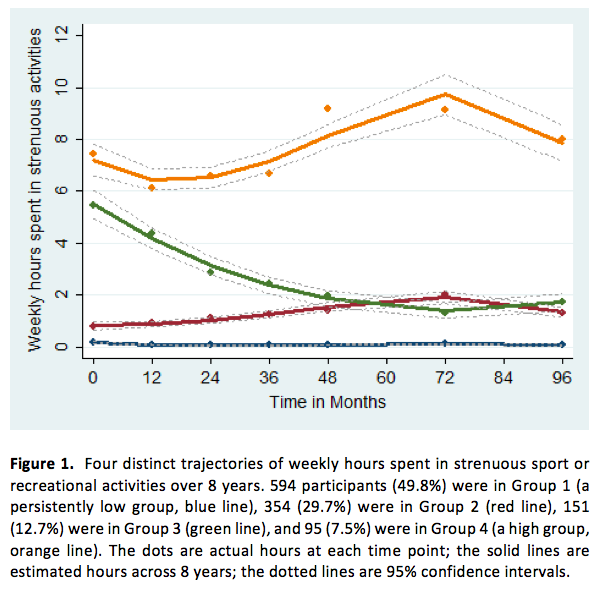Session Information
Session Type: ACR Poster Session A
Session Time: 9:00AM-11:00AM
Background/Purpose: Participation in exercise, sport or recreational activities offers multiple health benefits, promotes wellbeing and weight management, and preserves function and quality of life. Staying physically active is important for persons at high risk for knee OA, but without radiographic disease, for helping to prevent the downward spiral of functional decline and disability onset associated with OA development and progression. Understanding how activity levels evolve over time and associated baseline modifiable factors will inform strategies for activity promotion. In persons at high risk for knee OA, we identified distinct trajectories of weekly hours spent in strenuous activities over 8 years and baseline factors associated with membership in each trajectory.
Methods: Weekly hours engaged in strenuous activities, such as jogging, swimming, cycling, singles tennis, aerobic dance, skiing (downhill or cross-country) or other similar activities were estimated using items in the PASE (Physical Activity Scale for the Elderly) questionnaire over 8 years. OAI Participants KL 0 in both knees and with ≥ 3 time points of PASE data were included. We used latent mixture modeling with zero-inflated Poisson distribution to identify groups with a similar underlying trajectory of weekly hours spent in strenuous activities. Multinomial logistic regression was used to model associations of baseline predictors with membership in each trajectory. Multivariable models were created by including variables with p ≤ 0.20 in the univariate model. Backward selection (removing variables with multivariable p > 0.20) was used to create final models.
Results: Among 1194 OAI participants [age: 58.4 (SD 8.9) years, BMI: 26.8 (4.5) kg/m2, 58,4% women], we identified 4 distinct trajectories of weekly hours spent in strenuous activities (Figure 1). Nearly 50% of the participants reported zero hour and 30% reported 1-2 hours per week over 8 years. As shown in the table, being older, greater BMI, and more severe knee pain were each associated with a reduced likelihood, and being a college graduate and having stronger knees with an increased likelihood of being in the high trajectory (Gr. 4 vs. 1). Depressive symptoms were associated with a reduced likelihood of being in Gr. 3 vs. 1 or Gr. 2 vs. 1 (Table).
Conclusion: In persons at high risk for knee OA, we identified 4 distinct trajectories of weekly hours spent in strenuous activities over 8 years. Reducing BMI, knee pain, and depressive symptoms and improving knee strength may potentially facilitate continued participation in exercise, sport, or recreational activities.
|
Table 1. Associations of baseline predictors (independent variables) with membership in each of the weekly hours spent in strenuous activities trajectory groups (reference group: membership in Group 1 – persistently low) Multinomial logistic regression models results for relative risk ratios (95% confidence intervals) n = 1194 |
|||
|
Baseline predictors |
Group 2 n = 354 |
Group 3 n = 151 |
Group 4 n = 95 |
|
Age (per 5-year increase) |
0.84 (0.77, 0.92) |
0.90 (0.81, 1.01) |
0.85 (0.73, 0.99) |
|
BMI (per 5-kg/m2 increase) |
0.94 (0.80, 1.11) |
0.75 (0.60, 0.95) |
0.66 (0.48, 0.90) |
|
Other Races (reference: White) |
1.78 (1.14, 2.78) |
1.15 (0.64, 2.07) |
1.23 (0.55, 2.74) |
|
Depressive symptoms (yes vs. no) |
0.49 (0.28, 0.88) |
0.38 (0.16, 0.92) |
0.83 (0.36, 1.92) |
|
WOMAC pain (range: 0-20) (per 4-unit increase) |
0.67 (0.53, 0.85) |
0.60 (0.42, 0.85) |
0.49 (0.30, 0.79) |
|
Knee extensor strength (Newton) (range: 27-880) (per 60-Newton increase) |
0.94 (0.89, 1.06) |
1.06 (0.94, 1.13) |
1.27 (1.13, 1.43) |
|
Education level (college graduate and above vs. non-college graduate) |
1.68 (1.23, 2.29) |
2.51 (1.58, 3.98) |
1.90 (1.06, 3.41) |
To cite this abstract in AMA style:
Chang AH, Lee J, Almagor O, Chmiel JS, Szymaszek J, Sharma L. Trajectories of Sport or Recreational Activities over Eight Years and Associated Factors in Persons at Risk for Knee Osteoarthritis [abstract]. Arthritis Rheumatol. 2018; 70 (suppl 9). https://acrabstracts.org/abstract/trajectories-of-sport-or-recreational-activities-over-eight-years-and-associated-factors-in-persons-at-risk-for-knee-osteoarthritis/. Accessed .« Back to 2018 ACR/ARHP Annual Meeting
ACR Meeting Abstracts - https://acrabstracts.org/abstract/trajectories-of-sport-or-recreational-activities-over-eight-years-and-associated-factors-in-persons-at-risk-for-knee-osteoarthritis/

